Natural Wonders of USA Portrayed by Frank Sirona
Frank Sirona′s captivating photos of natural wonders, especially in the Southwest United States, are truly awe-inspiring. His pursuit of perfection in large-format photography has yielded amazing landscape photos that encompass places such as Zion National Park, the Colorado Rocky Mountains, Yosemite National Park, etc. The beauty of his photographs derives from his deep understanding of the changing light of a scene, the precision with which he uses his equipment, deliberate and meticulous preparation in composition, and patience while waiting for the perfect ″window of opportunity″ to capture the moment. His breathtaking landscapes are characterized by vibrant red terrains, fascinating rock formations, sensual curvy canyons, and snowy winter solitude. Frank employs traditional large-format photographic techniques that are extremely involved and used by other landscape photographers such as Ansel Adams.
We are honored to be able to talk with Frank about his astonishing art. We hope you enjoy the following.
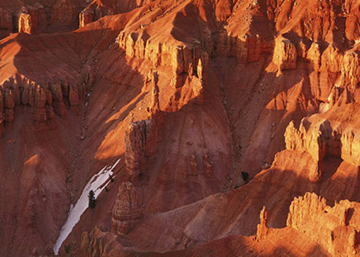
Q: Your photos are definitely amazing and unique in terms of size and presentation. Please explain to us what large-format photography is and what are its unique features.
A: There′s a number of aspects that technically set apart large-format (″LF″) photography from digital photography, but I′d say these three are the most important ones: First, in LF photography light is recorded on film, not a digital sensor. This results in a number of differences, some more obvious (such that you don′t need to worry about empty batteries when in the field) and some more subtle (for example the color rendition which differs between film and a sensor). Digital cameras and the processing of raw data have become much better in recent years, but there′s still some pleasant ″softness″ to prints obtained from film which I prefer to the somewhat more harsh look digital photos often have. Second, as the name already tells, the pieces of film which are used are large. The predecessors of today′s DSLRs, the so-called 35 mm cameras, used rolls of film 35 mm wide, and the negative size was 24 x 36 mm. In contrast, an LF camera is loaded with sheets of film which typically are 4×5″, 5×7″or 8×10″ large (there are also some exotic, even larger formats). For most of my work I′m using a 5×7″ film which is almost 30 times the size of a 35 mm negative. Accordingly, much more detail can be recorded, and that′s the major strength of LF photography: Thanks to the incredible richness of detail even large prints (e.g., 50 x 60″) are tack sharp. Finally, LF cameras are unique in allowing for perspective control and for the management of depth-of-field, by adjusting the relative position and orientation of lens and film plane. That being said, the technical peculiarities of LF cameras result in what I deem the most important difference to digital photography: The bulk and weight render taking a photograph a much more conscious process. You won′t just take a snapshot of your cat when one single shot costs you 10 minutes to set up your camera and $10 for a sheet of film and its development. Rather, there is a strong motivation to make sure everything is perfect (composition, light, the concept behind an image) before clicking the shutter. This is what really sets apart LF photography: a high degree of perfection and a sense of determination which are often missing from photos taken with smaller cameras.

Q: What type of camera and imaging system do you use? Are they digital? If not, why not?
A: I′m doing almost all my landscape work with an old, swiss-made 5×7″ studio camera. This Sinar has not only been built like a tank so that I don″t need to worry when carrying it through rugged terrain, but it also provides an extreme degree of precision (that′s what you′d expect from a Swiss camera, after all!) which fits well into my workflow. In large-format photography very precise focussing and adjustment of depth-of-field are required, and for this you can′t beat these Sinars. I certainly will continue to use film for many years to come, since even today digital cameras haven′t caught up with the resolution and sharpness obtainable when using large-format film. DSLR (digital single-lens reflex) cameras may be great for magazine photography, but as soon as large prints of high quality are the goal, their resolution is insufficient. Professional, so-called ″digital medium format cameras″ provide a higher resolution than DSLRs, but still don′t hold a candle to the large-format film, and moreover they are prohibitively expensive. Last but not least, film has a very specific ″look″ which I find very pleasant – interestingly that′s often compared to the difference of the cold technical perfection of CDs as opposed to the warm sound of records.
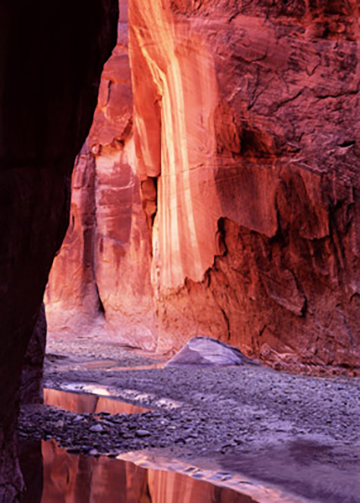
Q: Do you use any photo editing software such as Photoshop?
A: While analog photography has significant advantages, digital printing has made huge progress and has become better than the classic lab process. My exhibition prints are made with a LightJet laser printer which provides just incredible results. However, for using a digital printer, the developed film needs to be digitized first, which is done by the use of a scanner. In order to preserve all the nuances both in the shadows and the highlights of a piece of developed film, a good scan is relatively ″flat″. This scan then needs to be converted back to an image file which corresponds to the appearance of the original image as closely as possible, and for this processing Photoshop, with all its adjustment options, is a perfect tool.

Q: Please share with us your favorite places to shoot and why.
A: My favorite region is the Colorado Plateau with its countless canyons and amazing rock formations. There are few places on earth where the geologic processes which have shaped our world are more apparent. At the same time many of these formations have a great aesthetic appeal, and combining in a single image both, the view of the scientist and the view of the artist, has become the focus of my work. A great bonus is the stable weather conditions in the Southwest (taking the monsoon season aside), which allows to work on a regular basis with the kind of wonderful early and late light which is available only when the sun isn′t blocked by clouds. One place which has become a favorite of mine lately is Zion National Park, despite the ever-increasing masses of visitors. Zion has so many different faces – it′s got canyons, mesas, a perennial stream, fantastic fall colors, snow in the winter months – you name it. It doesn′t offer much solitude any longer like it did back in the days of my very first visit many years ago, but it still is just a place of incredible beauty.

Q: You have stated on your website, ″Photography without Compromise″ and lighting is the No.1 pillar. Please elaborate on what this means.
A: In photography light simply makes the difference between the ordinary and the extraordinary, and in landscape photography it will be quite difficult to create an appealing image when the light doesn′t cooperate. For every subject there is a condition of light that suits that subject best – change the illumination, and a jaw-dropping subject may lose all its appeal. A well-known example is the photography of leaves, for which the subdued light of a cloudy day is ideal. As soon as the sun comes out, the light will be too harsh and contrasty and destroys the subject. What I very much like is the light before sunrise and after sunset. It may sound counterintuitive, but colors can be very intense then, while at the same time the light is very soft. Again, direct sunlight can totally destroy the appeal of a scenery which looks just beautiful before sunrise. Around sunrise the quality of light changes dramatically within minutes, and sometimes there′s a window of only a few seconds during which the light is perfect. Identifying this perfect moment and capturing it with quite slow equipment is a challenge. The reward can be a unique image though, so it certainly is worth the effort to persevere until the desired moment has been captured. This is part of what I call ′Photography without Compromise″: always striving for the best possible result, and not accepting anything which doesn′t meet your highest expectations. Sometimes it takes me years until an idea I have for a particular image finally materializes on a sheet of film, but the deep connection I feel to such an image is worth all the effort.

Q: You believe print presentation is also another important element. Please let us know how you create your prints in such pristine quality.
A: The photographic print is the interface between photographer and audience, and as such the quality of a print and of its presentation is absolutely crucial. You can spoil the best image by printing it in low quality, and by not paying much attention on how the print is presented. As mentioned before, my exhibition prints are made using a high-end laser printer, exposing light-sensitive photographic paper with colored lasers. After developing the paper using a traditional wet lab process, the results are raw paper prints that already look quite good. However, that′s only the first step; next, the prints need to be mounted somehow. I had been looking for a good solution for years, but nothing was really convincing. Then I came across the first ″DiaSec″ print I′d ever seen, and was blown away. For DiaSec a print is laminated behind a sheet of acrylic, providing a perfectly even print surface. However, what I still didn′t like was the strong reflections on the surface of the acrylic, which under non-optimal conditions can be quite distracting. I then had the idea to mount prints not behind the acrylic, but behind sheets of museum glass with an anti-reflective layer instead, and that turned out to be absolutely perfect. The brilliance of these ″UltraSec″ prints is simply without compare, with fresh but not exaggerated colors as if the print was still wet from developing, and with an amazing sense of depth caused by the thickness of the glass. Even though I′m using this presentation technique for years now, I′m still amazed today to see an unmounted print and the same print after UltraSec mounting side-by-side — it′s just incredible how the appearance of the print is changed.

Q: You have made a series of amazing photos at Yosemite National Park during the winter. Please share with us this experience and how it differs from shooting desert scenes.
A: At Yosemite, the light is very different – in the valley you won′t have the early morning or late afternoon sun directly hit the canyon floor. Thus, you have to work more with indirect light. Weather conditions can be quite interesting, and if you′re fast enough (always a limiting factor when using LF equipment), you can capture really exciting light conditions. On the other hand one must say that nowadays Yosemite is quite crowded throughout the year, so that despite its unequaled beauty I prefer to be far out in the Desert Southwest where you still can find the solitude and silence which I need to fully concentrate on my subjects.
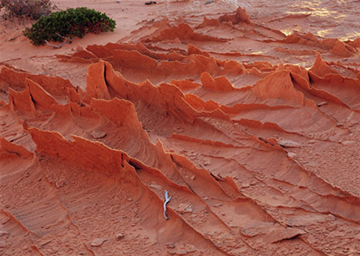
Q: Has your educational background in natural science helped to shape or influence your photography?
A: It absolutely has. My background in science totally changed the way I perceive nature. While not a tiny bit of awe has gone lost by better understanding what′s going on out there, it′s extremely pleasing to have this layer of understanding added to the mere enjoyment of nature′s beauty. In my photography these two aspects – the celebration of beauty and the understanding of how the natural forces have shaped each of my subjects – form a synthesis by bringing each of the two into a new context. I have called this the Approach of the Painter and the Scientist, and by that I mean to view one and the same natural phenomenon – say, for example, a weird erosion form – from two totally different angles. And what comes here in again is the technique I′m using, large-format photography, because it′s only the almost unlimited amount of detail in a print which allows the beholder to zoom into the image, from hillside to rock to the grain of sand, and thus to switch forth and back from the grand scene to the tiny details which tell us which forces have been at work in a particular scene.
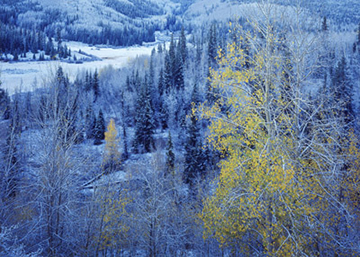
Q: Please share with us a past project that was most enjoyable to you and why.
A: A project which comes to mind here would be my work on fall colors in the Rocky Mountains. Actually, this was a kind of side-show to my main body of work, both in terms of location and of subject. That being said, fall in the Rockies is not only a colorful feast for the senses, but from the perspective of a photographer can be quite easy to handle. Good light often is available essentially all day long, since photography of leaves and trees is best done on overcast days or in the shadow and not in the short time windows you′d typically choose for photographing in the desert.
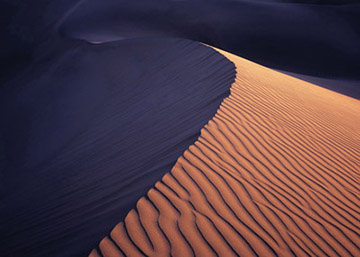
Q: We are interested in your current project. Please tell us what it is and when it will be released into the public.
A: One subject I became very much interested in recently is sand dunes. From an aesthetic standpoint, dune photography can yield highly satisfying results. However, this sort of subject comes with a number of technical challenges. One of the more trivial ones is to reliably keep the ubiquitous sand out of your equipment at a place that is shaped by the photographer′s natural enemies, sand and wind. Then, unless you find a very remote dune field, tracks left by other visitors are a steady problem. Last, not least it′s much more difficult than one would assume to find vantage points from where it′s possible to look along attractively curved ridges running at the right angle to the incoming light, while excluding the horizon which would almost inevitably introduce a distracting element. Finally, one needs to keep in mind that again there′s a time window of just a few minutes in the morning and a few minutes in the evening (always provided there are no cloud banks in the way) during which the light is at its best. Given the time it takes to prepare a shot with a LF camera this inevitably limits the number of compositions one can try to at most two per day, which requires thorough anticipation: at which exact angle will the light come in at the decisive moment, how does this translate into an arrangement of three-dimensional curved slopes either being hit by the sun or not, and will the projection of this arrangement into the two-dimensional film plane translate into a harmonic arrangement of lit areas and areas in the shadow? Under these circumstances, the yield of a full week in the dunes maybe just one single image good enough to fulfill the criteria of a portfolio shot, but to me, the graphic simplicity of well-made dune images is well worth the effort.
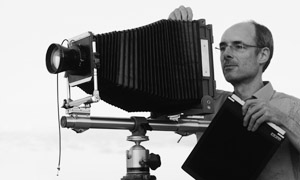
We thank Frank Sirona for his detailed and thoughtful explanation of his large-format photography. His pursuit of excellence in presenting the beauty of the natural wonders of the United States definitely leaves a deep impression on the public. We look forward to seeing more American natural beauty portrayed by Frank.
Frank′s Instagram: @franksirona and website: www.franksirona.com